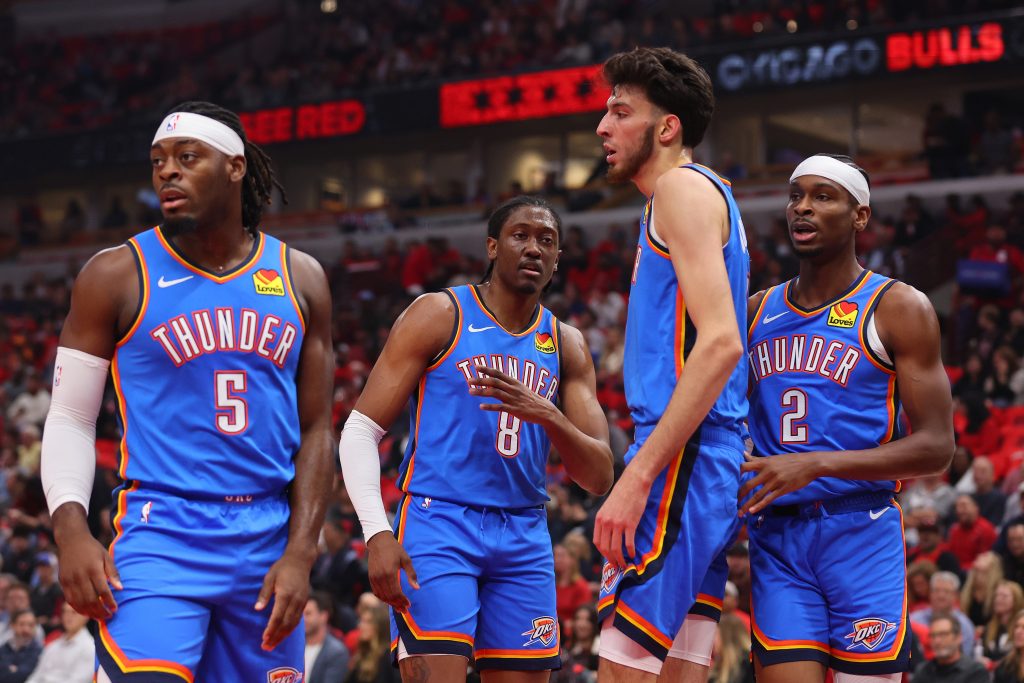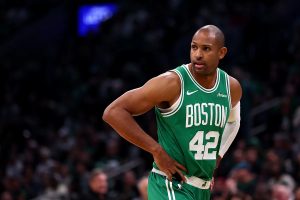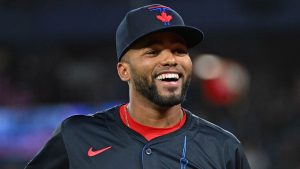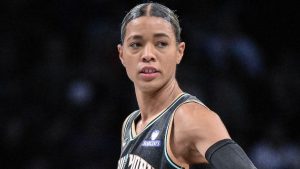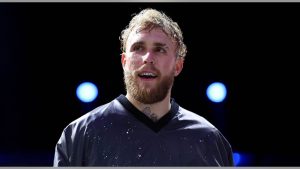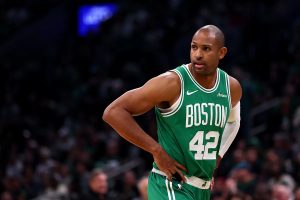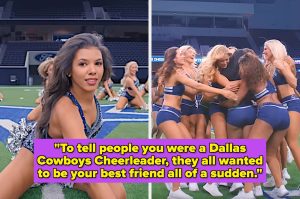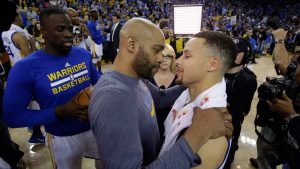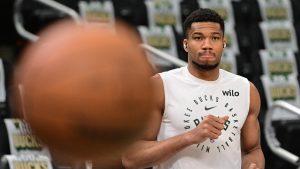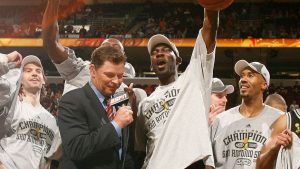Here’s a number that will make your head spin: $822 million.
That’s what the Oklahoma City Thunder have committed in extensions for their star trio of Shai Gilgeous-Alexander, Jalen Williams, and Chet Holmgren.
It makes sense. They’re the team’s best players, and the organization is just coming off its championship in which it was led by, well, two of them.
(We’ll get there.)
For an organization that cheaped out of retaining James Harden after its 2012 NBA Finals appearance, the Thunder have turned the page and sent a strong message to the rest of the league: We’re willing to pay to potentially become a dynasty.
This is, unquestionably, a great sign to send to players, agents and fans. The potential of becoming a perennial powerhouse and being the inheritor of the Golden State Warriors’ dominance in the mid 2010s could lead to an extreme rise in popularity worldwide and turn the Thunder into a basketball brand.
This, in turn, will allow them to basically print money for decades, likely recouping their major investment. (Just ask the Chicago Bulls, who are still shamelessly milking the Michael Jordan years for every last cent, 27 years after their last title.)
Of course, it’s not all sunshine and rainbows. Because like Uncle Ben said, with great paychecks, come great responsibility.
So let’s get into it all.
The Holmgren conundrum — is there one?
While the Thunder didn’t do anything wrong in extending Holmgren to a five-year max that could be worth $250 million because he was inevitably going to get a similar offer next offseason if they let him test restricted free agency, it’s a lot of money for a guy who has appeared in just 114 regular-season games over the course of his three-year career.
Additionally, Holmgren hasn’t exactly performed at a max level in the playoffs, with his shooting percentages dropping and his rebounding becoming fairly pedestrian. In the 23 games of OKC’s title run, Holmgren averaged 15.2 points, 8.7 rebounds and 1.9 blocks while shooting 46.2% from the floor and 29.7% from 3-point range.
But that’s not really the main issue. After all, the guy will defend at a high level, block a ton of shots and his potential is sky high.
The actual issue is how the Thunder expect to get bang for the buck on his deal when he’s likely to forever be the team’s third guy.
As we’ve seen, historically, in any Big 3 formation, someone will find himself on the outside looking in. Chris Bosh was clearly the third wheel in Miami, Harden sacrificed shots and touches next to Kevin Durant and Russell Westbrook in OKC, and Ray Allen became an occasional afterthought when he joined the Celtics.
Odds are good Holmgren will become that player for the Thunder, despite the fact his talents are probably worth top billing on 15 other teams.
So, what are the Thunder paying for here?
Are they handing him a max extension to simply not lose that third cog in the machine, knowing full well they’ll never get traditional max-money production in return?
Or, are they hoping Holmgren will somehow find a way to break the third-man barrier and begin to produce at an All-NBA level?
[Get more Thunder news: Thunder team feed]
Frankly, either option is fine. There isn’t a wrong answer. But the organization must prepare itself for the likelihood Holmgren’s deal could be viewed as a negative a few years from now — if he more or less remains the same player.
Fortunately for him — and kudos to Thunder fans for accurately banging this drum all year — the hip injury that caused him to miss a big chunk of the regular season was a freak accident, and he didn’t seem 100% during the playoffs.
This has led to optimism in regard to his future health, with his struggles in the playoffs simply being a product of him still being in the process of nursing himself back to health.
While it’s a perfectly reasonable rebuttal to any skepticism of Holmgren’s contract, it doesn’t remove the notion that most third-option max players have practically never offered production worth their compensation level, and thus it could eventually become a topic of conversation.
The depth could suffer, if ownership gets cold feet
So let’s get one thing absolutely straight in all of this:
Given the Thunder already have significant depth on their hands, as well as incoming draft picks, there is little risk in exceeding the second apron. The second apron does handcuff teams to a very large extent, but if you have stars and can go 10-12 players deep, you’re mostly fine. Oklahoma City can keep everything intact, if it so chooses. It’ll have to pay through the nose for it, but it can.
The challenge doesn’t lie in not having upgrade options, but rather the pockets of ownership.
Listen carefully, Thunder fans.
Given how the team is currently constructed, with several key role players locked in for long-term money and the fact you can still extend them on future deals, ownership can never go out and publicly argue for the dumping of salaries to gain more flexibility in roster construction.
For the Thunder specifically, this is not a problem.
You can, as an organization, decry the limitations of the second apron if you’re too top heavy and can’t afford to strengthen your bench, for example.
You can decry the difficulty in making trades by not being able to aggregate contracts.
But the Thunder? The team with tons of incoming draft picks and a core that runs essentially 12 deep?
That’s not an excuse they can make, and they shouldn’t even try.
In fairness to management and ownership, we’ve yet to see anything that indicates a concern about this moving forward. If anything, the organization has spent money like there’s no tomorrow, even handing Jaylin Williams $24 million over three years this summer.
But the organization has to stay as committed to this team three years from now as it is today. Any argument for the opposite is utterly ridiculous.
The big picture
It’s expensive to win in the NBA, and it’s particularly expensive to keep winning. But so far the Thunder have done everything right.
They’ve gotten rid of guys, like Josh Giddey, who couldn’t play real minutes in the playoffs, and they’ve gathered pieces that work in unison.
More importantly, they seem willing to pay for those pieces, even long term. They gave Alex Caruso an extension worth $81 million over four years and are paying Lu Dort over $18 million per year.
Even role players such as Aaron Wiggins and Isaiah Joe are both earning over $10 million per year, and it shouldn’t come as a surprise if Cason Wallace gets extended when he’s eligible next summer.
So, their dedication is admirable. But it has to stick. They’re on the highway and can’t veer off their current trajectory. At least not if they’re serious.
Here’s a number that will make your head spin: $822 million.
That’s what the Oklahoma City Thunder have committed in extensions for their star trio of Shai Gilgeous-Alexander, Jalen Williams, and Chet Holmgren.
Advertisement
Advertisement
Advertisement
It makes sense. They’re the team’s best players, and the organization is just coming off its championship in which they were led by, well, two of them.
(We’ll get there.)
For an organization that cheaped out of retaining James Harden after its 2012 NBA Finals appearance, the Thunder have turned the page and sent a strong message to the rest of the league: We’re willing to pay to potentially become a dynasty.
This is, unquestionably, a great sign to send to players, agents and fans. The potential of becoming a perennial powerhouse and being the inheritor of the Golden State Warriors’ dominance in the mid 2010s could lead to an extreme rise in popularity worldwide and turn the Thunder into a basketball brand.
Advertisement
Advertisement
Advertisement
This, in turn, will allow them to basically print money for decades, likely recouping their major investment.
(Just ask the Chicago Bulls, who are still shamelessly milking the Michael Jordan years for every last cent, 27 years after their last title.)
Of course, it’s not all sunshine and rainbows. Because like Uncle Ben said, with great paychecks, come great responsibility.
So let’s get into it all.
While the Thunder didn’t do anything wrong in extending Holmgren to a five-year max that could be worth $250 million because he was inevitably going to get a similar offer next offseason if they let him test restricted free agency, it’s a lot of money for a guy who has appeared in just 114 regular-season games over the course of his three-year career.
Advertisement
Advertisement
Advertisement
Additionally, Holmgren hasn’t exactly performed at a max level in the playoffs, with his shooting percentages dropping and his rebounding becoming fairly pedestrian. In the 23 games of OKC’s title run, Holmgren averaged 15.2 points, 8.7 rebounds and 1.9 blocks while shooting 46.2% from the floor and 29.7% from 3-point range.
But that’s not really the main issue. After all, the guy will defend at a high level, block a ton of shots and his potential is sky high.
The actual issue is how the Thunder expect to get bang for the buck on his deal when he’s likely to forever be the team’s third guy.
As we’ve seen, historically, in any Big 3 formation, someone will find himself on the outside looking in. Chris Bosh was clearly the third wheel in Miami, Harden sacrificed shots and touches next to Kevin Durant and Russell Westbrook in OKC, and Ray Allen became an occasional afterthought when he joined the Celtics.
Advertisement
Advertisement
Advertisement
Odds are good Holmgren will become that player for the Thunder, despite the fact his talents are probably worth top billing on 15 other teams.
So, what are the Thunder paying for here?
Are they handing him a max extension to simply not lose that third cog in the machine, knowing full well they’ll never get traditional max-money production in return?
Or, are they hoping Holmgren will somehow find a way to break the third-man barrier and begin to produce at an All-NBA level?
Frankly, either option is fine. There isn’t a wrong answer. But the organization must prepare itself for the likelihood Holmgren’s deal could be viewed as a negative a few years from now — if he more or less remains the same player.
Advertisement
Advertisement
Advertisement
Fortunately for him — and kudos to Thunder fans for accurately banging this drum all year — the hip injury that caused him to miss a big chunk of the regular season was a freak accident, and he didn’t seem 100% during the playoffs.
This has led to optimism in regard to his future health, with his struggles in the playoffs simply being a product of him still being in the process of nursing himself back to health.
While it’s a perfectly reasonable rebuttal to any skepticism of Holmgren’s contract, it doesn’t remove the notion that most third-option max players have practically never offered production worth their compensation level, and thus it could eventually become a topic of conversation.
So let’s get one thing absolutely straight in all of this:
Advertisement
Advertisement
Advertisement
Given the Thunder already have significant depth on their hands, as well as incoming draft picks, there is little risk in exceeding the second apron.
The second apron does handcuff teams to a very large extent, but if you have stars and can go 10-12 players deep, you’re mostly fine.
Oklahoma City can keep everything intact, if it so chooses. It’ll have to pay through the nose for it, but it can.
The challenge doesn’t lie in not having upgrade options, but rather the pockets of ownership.
Listen carefully, Thunder fans.
Given how the team is currently constructed, with several key role players locked in for long-term money and the fact you can still extend them on future deals, ownership can never go out and publicly argue for the dumping of salaries to gain more flexibility in roster construction.
Advertisement
Advertisement
Advertisement
For the Thunder specifically, this is not a problem.
You can, as an organization, decry the limitations of the second apron if you’re too top heavy and can’t afford to strengthen your bench, for example.
You can decry the difficulty in making trades by not being able to aggregate contracts.
But the Thunder? The team with tons of incoming draft picks and a core that runs essentially 12 deep?
That’s not an excuse they can make, and they’re shouldn’t even try.
In fairness to management and ownership, we’ve yet to see anything that indicates a concern about this moving forward. If anything, the organization has spent money like there’s no tomorrow, even handing Jaylin Williams $24 million over three years this summer.
Advertisement
Advertisement
Advertisement
But the organization has to stay as committed to this team three years from now as it is today. Any argument for the opposite is utterly ridiculous.
It’s expensive to win in the NBA, and it’s particularly expensive to keep winning. But so far the Thunder have done everything right.
They’ve gotten rid of guys, like Josh Giddey, who couldn’t play real minutes in the playoffs, and they’ve gathered pieces that work in unison.
More importantly, they seem willing to pay for those pieces, even long term. They gave Alex Caruso an extension worth $81 million over four years and are paying Lu Dort over $18 million per year.
Advertisement
Advertisement
Advertisement
Even role players such as Aaron Wiggins and Isaiah Joe are both earning over $10 million per year, and it shouldn’t come as a surprise if Cason Wallace gets extended when he’s eligible next summer.
So, their dedication is admirable. But it has to stick. They’re on the highway and can’t veer off their current trajectory. At least not if they’re serious.

